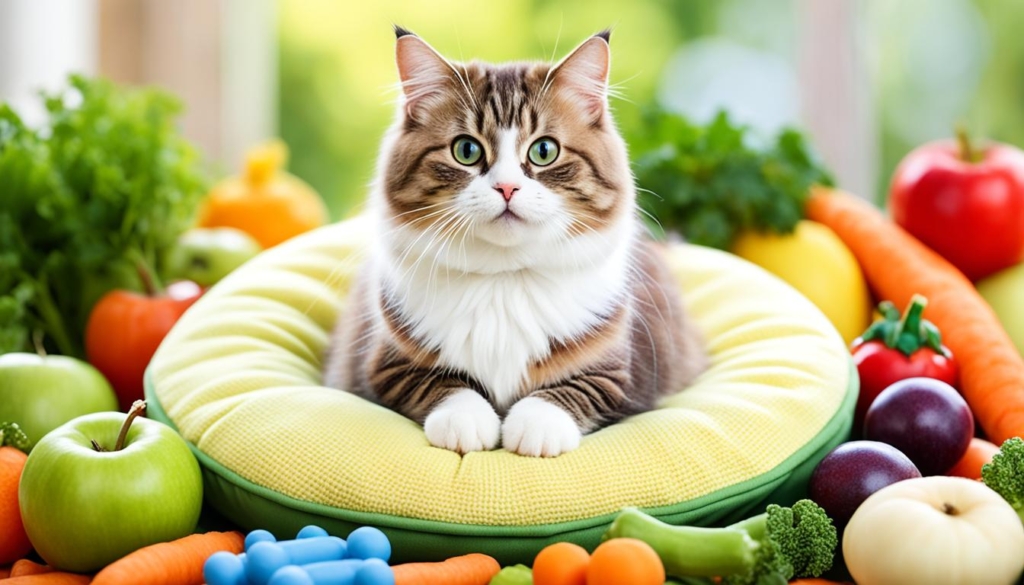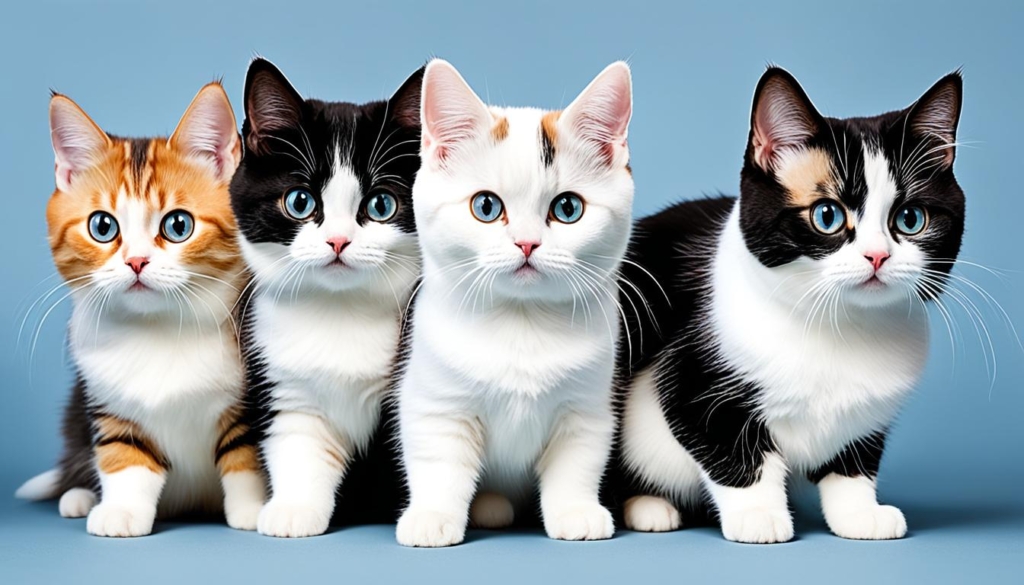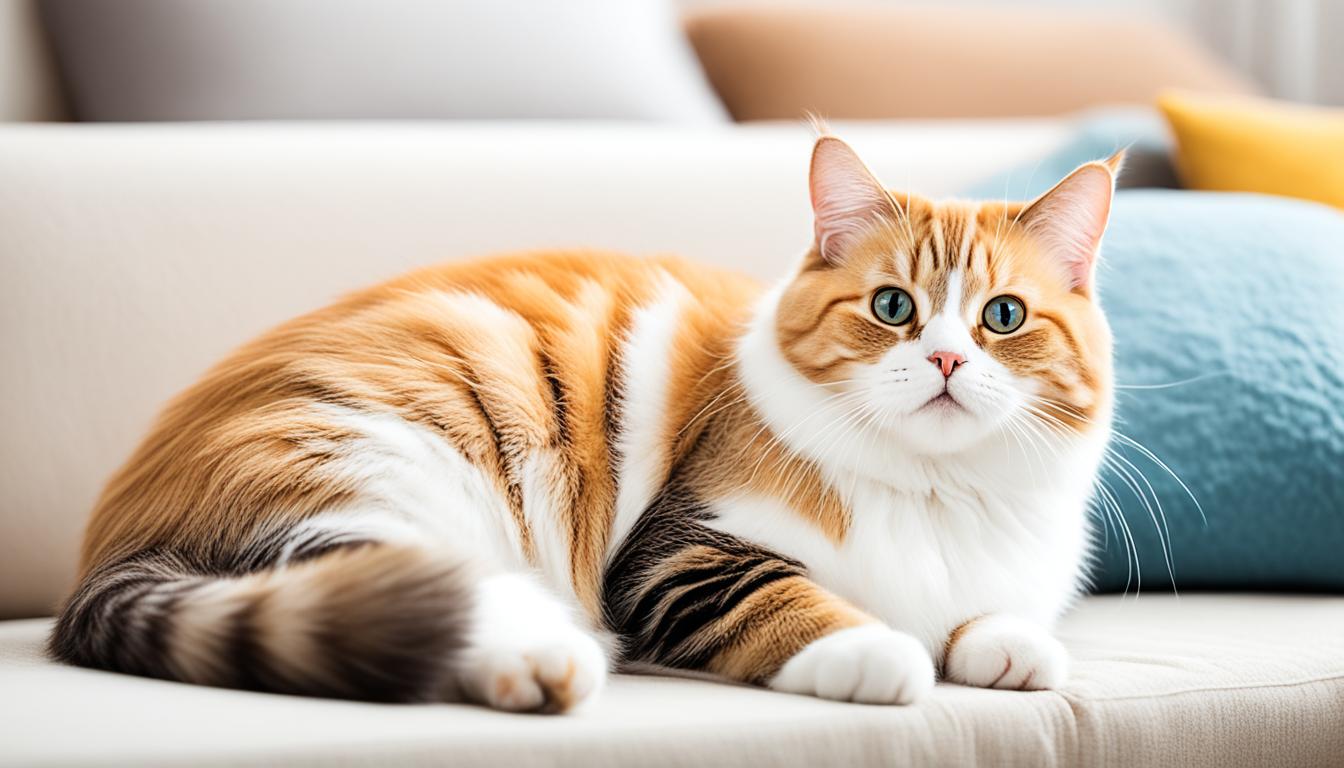The Munchkin cat is a new breed that has won many hearts with its short legs and playful nature. People were worried about health issues at first, but research shows they can live a long, healthy life. They usually live between 12 to 14 years.
This guide will look into the personality, temperament, and behavior of Munchkin cats. We’ll answer the big question: are they aggressive or not?
Key Takeaways
- Munchkin cats are known for their friendly, outgoing, and well-mannered temperament.
- They are highly intelligent and can be easily trained to perform tricks and commands.
- Munchkin cats are generally not considered an aggressive breed, but they may exhibit playful biting or scratching behaviors like other felines.
- With proper socialization and care, Munchkin cats can make excellent family pets, even in households with children or other pets.
- Regular veterinary check-ups are essential to address any potential health concerns and ensure the Munchkin’s wellbeing.
Munchkin Cat Personality and Temperament
Munchkin cats are known for their playful and energetic nature. They keep this trait even as adults. Despite being short, they are very curious and love to explore. They are smart and learn new tricks easily, making them great companions.
Playful and Energetic Nature
Munchkin cats have endless energy and love to play. They move fast, chasing toys and playing fetch. Their playful spirit is contagious, keeping their owners laughing with their fun actions.
Curiosity and Intelligence
These cats are always curious, always looking at their world with fresh eyes. They are smart and learn tricks quickly. This makes them great pets for those who like their curious nature.
| Trait | Description |
|---|---|
| Playfulness | Munchkin cats are known for their boundless energy and playful behavior, often engaging in lively games and chasing toys well into adulthood. |
| Curiosity | These felines are highly inquisitive, exploring their surroundings with enthusiasm and delight in new discoveries. |
| Intelligence | Munchkin cats are intelligent, easily trained to perform simple tricks and respond to voice commands. |
| Sociability | Munchkin cats are described as affectionate and sociable, enjoying interaction with their owners and other pets. |
| Energy Level | Munchkin cats are known for their high energy levels, requiring regular playtime and exercise to stay healthy and content. |
“Munchkin cats are the perfect blend of playfulness and intelligence, captivating their owners with their boundless energy and inquisitive nature.”
Is Munchkin Cat Aggressive?
Munchkin cats are known for being friendly and social. They make great pets for many families. Their short legs don’t mean they are aggressive. Instead, they are playful, energetic, and curious.
During play, Munchkin cats might be a bit rough, especially with young kids. It’s important to watch how they play to keep everyone safe. Their short size means they might not be as careful, which could lead to accidental scratches or bumps.
Munchkins usually get along well with other pets, like dogs, if they are introduced and socialized right. They are bold and can live with other animals in a household. But, it’s still important to watch how they interact to stop any fights.
In short, Munchkin cats aren’t usually aggressive. But, they do need careful owners to keep everyone safe and happy. With the right care and watching over them, these cats can be loving and fun pets.
| Trait | Description |
|---|---|
| Temperament | Friendly, social, and playful |
| Aggression | Rarely aggressive, but can be unruly during playtime |
| Interaction with Children | Require supervision due to their short stature and energetic nature |
| Interaction with Other Pets | Generally tolerant and can co-exist peacefully with other animals |
Munchkin Cat Breed History
The Munchkin cat’s unique look comes from a genetic mutation found in the UK in the 1940s. The breed got its official recognition in the 1980s. This was when Munchkin kittens were found in Louisiana by a cat named Blackberry.
Discovery and Origin
In 1983, Blackberry, a pregnant black Munchkin cat, had a litter. About half of the kittens had the short legs that make the Munchkin special. These kittens and their offspring have been found all over North America and the world. They brought back interest in this special cat breed.
Breed Recognition and Controversy
The Munchkin cat has become more popular, but it has also faced some criticism. The International Cat Association (TICA) put the Munchkin in its New Breed program in 1994. They fully recognized the breed in 2003. Yet, some groups are slow to accept the Munchkin. They worry about the genetic mutation and health problems linked to the short legs.
| Munchkin Cat Breed History | Key Facts |
|---|---|
| Discovery and Origin |
|
| Breed Recognition |
|
“The gene responsible for the short legs of Munchkin cats is a natural mutation that does not lead to mobility or spinal issues.”
Physical Characteristics of Munchkin Cats
Munchkin cats stand out with their unique look. They have short, stubby legs that make them different from other cats.
Size and Weight
Munchkin cats are small to medium in size. Males weigh between 6 to 9 pounds, and females weigh from 4 to 8 pounds. They have a sturdy build despite their size, thanks to their thick torso.
Short-Legged Appearance
The Munchkin cat’s short legs are its most notable feature. This comes from a genetic mutation called the “Munchkin gene.” It causes dwarfism-like effects. Yet, their legs don’t affect their balanced body, which includes a tail as long as their body.
They have a round head with clear cheekbones and big, alert eyes. Their fur comes in many colors and patterns, making them look diverse and cute.
“Munchkin cats are like the puppies of the cat world, with their adorable short legs and playful personalities.”
Even though Munchkins are cute, their genetic condition has caused debate in the cat world. Responsible breeders focus on the health and happiness of these special cats.
Caring for a Munchkin Cat
Munchkin cats stand out with their short legs. They need special care to stay healthy and happy. Keeping up with their grooming is a big part of this.
Grooming Requirements
Munchkin cats shed often and need regular grooming. Short-haired ones should be brushed once a week. This removes loose hair and spreads natural oils. Long-haired Munchkins need brushing or combing twice a week to avoid mats and tangles.
It’s also key to trim their nails and clean their ears with a vet-approved cleanser. This keeps them healthy and comfy.
Keeping a Munchkin cat busy and happy is important. Give them puzzles, toys, and brain games. These activities meet their curiosity and intelligence. They also help with physical activity, which is vital for their unique body shape.
By sticking to a grooming routine and providing fun activities, Munchkin cat owners can keep their pets healthy, happy, and well-groomed.
Munchkin Cat Health and Lifespan
Munchkin cats are generally healthy cats. Early worries about their health were unfounded. They don’t have the back problems some thought they would. On average, they live between 12 to 15 years with proper care.
Despite their short legs, Munchkin cats are as healthy as other cats. They might face health issues like osteoarthritis. Owners should watch out for hormonal imbalances, pancreatitis, and breathing problems due to their unique look.
| Health Condition | Prevalence |
|---|---|
| Dental Disease | 50-90% of cats aged four years or older |
| Heart Disease | Affects approximately 1 in 10 cats worldwide |
| Osteoarthritis | Common in Munchkin cats due to their short limbs |
| Hyperthyroidism | Common in middle-aged or senior cats, not breed-specific |
| Chronic Kidney Disease | More common in older cats due to lifetime kidney damage |
| Type II Diabetes | Common in overweight and older cats with high-carb diets |
| Feline Lower Urinary Tract Disease | Presents a variety of urinary system disorders |
Munchkin cats might also have lordosis, a curved spine, and pectus excavatum, a chest deformity. These can make breathing hard. Regular vet visits and good care are key to their health and happiness.
“Some veterinarians are concerned about lordosis in Munchkin cats, a condition involving a downward curvature of the spine that can affect heart and lung function.”

Munchkin Cat Cost and Expenses
Getting a Munchkin cat means thinking about the money you’ll spend. The cost to buy a Munchkin cat can be quite different. It ranges from $1,500 to $4,500. This depends on the breeder’s reputation, the cat’s quality, its coat color, and how old it is.
After buying a Munchkin cat, you’ll have monthly costs. These can be $15 to $40 for food, $20 to $70 for grooming, and $100 to $300 for vet care. Some health issues, like hyperthyroidism or pancreatitis, can cost even more, between $1,800 to $2,500 or $400 to $1,200 respectively.
Some pet owners buy insurance for their Munchkin cats. This can cost about $15 to $50 a month. It helps cover unexpected vet bills.
Setting up a home for a Munchkin cat also costs money. You’ll need to buy a bed, collar, litter box, toys, and a first aid kit. These items usually cost around $450 to $600.
Over a Munchkin cat’s 12 to 15-year life, owning one can cost $22,500 to $30,000. This includes the cost of care and the cat’s lifespan.
| Expense Category | Estimated Cost |
|---|---|
| Purchase Price | $1,500 – $4,500 |
| Monthly Diet | $15 – $40 |
| Monthly Grooming | $20 – $70 |
| Monthly Medical Costs | $100 – $300 |
| Pet Insurance | $15 – $50 per month |
| Initial Setup Costs | $450 – $600 |
| Estimated Lifetime Costs | $22,500 – $30,000 |
Thinking about the cost is key when considering a Munchkin cat as a pet. It helps ensure you’re ready for the responsibilities and joys of owning one.
Munchkin Cats and Children
Munchkin cats are friendly and social, making them great for families with kids. But, they are playful and energetic. So, they need careful watching when with young kids. Teaching them how to be together can make sure they get along well.
These cats are smart and love to bond with their people, including kids. Their small size and quick movements can really catch a child’s eye, leading to fun times. But, they might not be as gentle as some other cats. So, grown-ups should watch how they play to keep everyone safe.
- Munchkin cats are usually good with kids, but grown-ups should watch them play.
- Teaching Munchkin cats and kids how to be together can make their relationship strong and happy.
- Their curious and playful nature can be fun for kids, but they need careful watching because of their small size and lots of energy.
Teaching kids how to be kind and careful with Munchkin cats can help everyone enjoy their time together. With the right way of doing things, Munchkin cats can be great pets for families with kids.
Munchkin Cat Breed Variations
When Munchkin cats are mixed with other breeds, they create interesting hybrids. These include the Minskin, the Napoleon (or Minuet), and the Lambkin.
The Minskin comes from a Munchkin and either a Sphynx or a Devon Rex. It has the Munchkin’s short legs and the other cat’s unique coat. Minskins are known for being playful and charming.
The Napoleon (also called the Minuet) is a mix of a Munchkin and a Persian. They have the Munchkin’s short legs and the Persian’s long, luxurious fur. This makes them look truly regal.
The Lambkin is a mix of a Munchkin and a Selkirk Rex. It combines the Munchkin’s short legs with the Selkirk Rex’s curly coat. This creates a cat that looks like a cuddly teddy bear, winning over cat lovers easily.
| Breed Variation | Height | Weight | Lifespan |
|---|---|---|---|
| Minskin | 6-8 inches | 5-8 pounds | 12-15 years |
| Napoleon/Minuet | 6-9 inches | 6-10 pounds | 12-15 years |
| Lambkin | 6-8 inches | 6-9 pounds | 12-14 years |
These Munchkin cat variations show how versatile the breed is. Breeders have created unique and captivating cats. Whether it’s the Minskin’s exotic look, the Napoleon’s regal charm, or the Lambkin’s cuddly nature, there’s a Munchkin mix for every cat lover.

Training and Socializing Munchkin Cats
Munchkin cats are playful and curious, making them easy to train. They are smart and respond well to positive reinforcement. Training them is rewarding for both the cat and the owner. Using interactive toys and giving consistent praise helps them learn good habits.
Socializing Munchkin cats is key to their happiness and well-being. It helps them get along with other pets and kids. Start socializing them young to teach them how to act around others. Playtime with supervision and slowly introducing them to new people and places makes them feel safe and confident.
- Munchkin cats are known for their playful and curious nature, making them relatively easy to train.
- Positive reinforcement techniques, such as rewarding with treats and praise, are effective in training Munchkin cats.
- Providing interactive toys and puzzles can help keep Munchkin cats engaged and well-behaved.
- Proper socialization from a young age is crucial for Munchkin cats to develop into friendly and well-adjusted feline companions.
- Supervised playtime and gradual introductions to new environments and people can help Munchkin cats feel secure and confident.
| Characteristic | Munchkin Cat |
|---|---|
| Trainability | Relatively easy to train using positive reinforcement |
| Socialization | Requires proper socialization from a young age to develop into friendly and well-adjusted cats |
| Exercise and Enrichment | Needs interactive toys, puzzles, and opportunities for physical and mental stimulation |
| Behavioral Challenges | Can be prone to overeating and weight gain, requiring careful monitoring and management |
Understanding the training and social needs of Munchkin cats helps owners. It ensures their pets grow into happy, healthy companions. They fit well into the household.
Conclusion
The Munchkin cat is a special and loving breed that has become more popular over time. Despite some early worries about health, these cats are usually healthy and make great friends. They are friendly, playful, and smart.
With the right care, Munchkin cats can be great pets for anyone. They are calm and friendly, fitting in well with new homes and people. But, they might face some health issues because of their special body type.
In short, the Munchkin cat stands out for its looks, friendly nature, and the need for careful ownership. Recognized as a breed in 1991, Munchkin cats win hearts with their unique charm and sweet traits.


